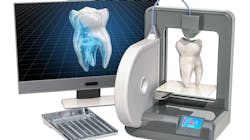Will 3D printing become the new manufacturing standard in dentistry?
For almost 40 years, dentistry has been associated with some form of CAD/CAM technology. We have been scanning teeth and models for decades and using CNC technology to mill and manufacture restorations. This process has been purely reductive, meaning a block or ingot is ground or milled down to produce the final restoration. However, with the advent of additive manufacturing—think 3D printing—we are entering a new era of dental manufacturing, and it’s going to be a very exciting time.
Traditional milling of dental restorations began with diamond grinding of glass ceramics. Feldspathic blocks were ground using dual-motor CNC machines to create inlays/onlays and crowns. This process would sometimes take upward of 30–45 minutes. At the time, this was an incredible innovation, but today that amount of time would be simply unacceptable.
Fast-forward to today and the milling processes are light years ahead of where we started. Today, I can send a restoration from my CEREC Primescan, which was designed using only a few clicks, to my Primemill and have a full-contour zirconia restoration manufactured in less than five minutes. It’s incredible to think how much further we can go with the speed, accuracy, and efficiency we have in our current technology. And that is only in the chairside world.
Additional reading:
Our laboratory partners have even more incredible technology that allows them not only to manufacture high-quality restorations efficiently, but on a much larger scale. Using large five-axis milling machines, laboratories can manufacture dozens of restorations at once out of a single puck of material. This has helped reduce the overhead for labs and increase their output. The modern dental lab technician may no longer have a CDT degree, but instead a computer science and graphic design background. Design and milling restorations will forever be a computer-guided process.
Within the last five to seven years, the world of 3D printing has exploded onto the dental scene. Formlabs was one of the first manufacturers to target the dental market with its Form2 printer. Using a vat filled with uncured resin, a very detailed laser would systematically cure the resin onto a build platform to create dental models from digital impressions. My first 3D printer would typically take 10–12 hours to manufacture a model, and that was completely acceptable at the time. In fact, it was exciting to finally eliminate alginate, stone, and a model trimmer!
Today, companies such as SprintRay and Dentsply Sirona are creating powerful and innovative 3D printing solutions that are speeding up the manufacturing process by leaps and bounds. On my Primeprint, I can produce a set of models in fewer than 30 minutes, which was unheard of just a few years ago.
With the rapid pace of innovation, research, and development—specifically regarding biocompatible materials and resins—it’s only a matter of time before additive manufacturing becomes the standard in dentistry. It took us almost 40 years to take a milled crown down from 40 minutes to five, and only two to three years to take a 12-hour printing process down to 30 minutes. We are already printing surgical guides and splints and provisionals today. I imagine within a few years, 3D printing of definitive restorations will have a significant place in the market. Regardless, I’m excited to just be along for the ride.
Editor's note: This article appeared in the May 2022 print edition of Dental Economics magazine. Dentists in North America are eligible for a complimentary print subscription. Sign up here.About the Author
Meena Barsoum, DMD, MS
Meena Barsoum, DMD, MS, a graduate of Case Western Reserve University, practices general dentistry in Chicago, Illinois, with a focus on CAD/CAM, implants, and digital dentistry. He serves as resident faculty at CDOCS in Scottsdale, Arizona. An international speaker, Dr. Barsoum has been a CAD/CAM and 3D CBCT user for over a decade and currently trains doctors all over the world on CEREC, aligners, and guided implant surgery. Contact him at [email protected].
Updated March 24, 2022

